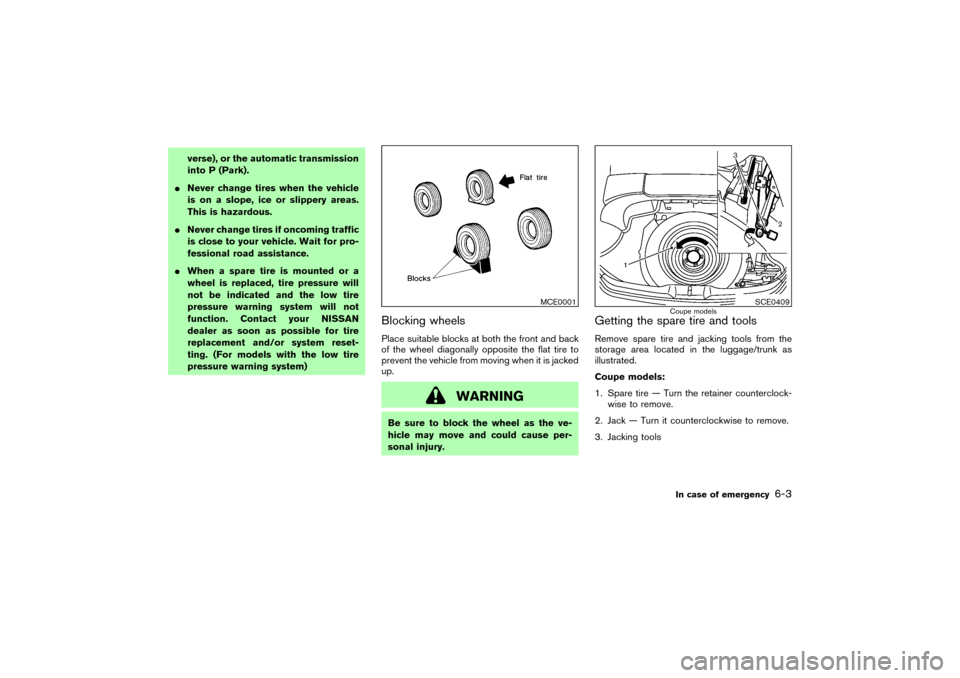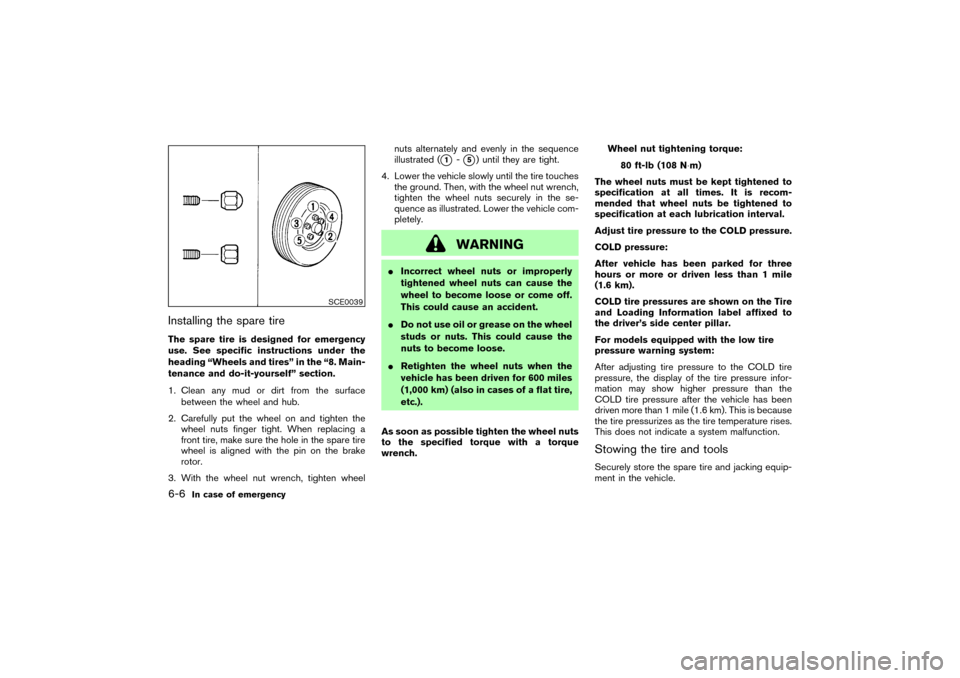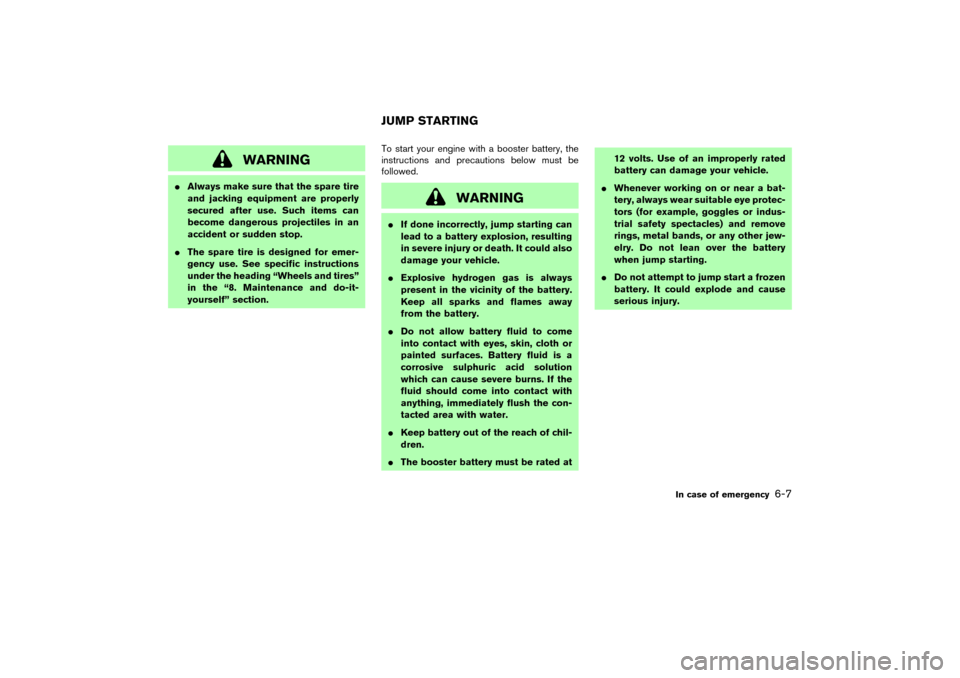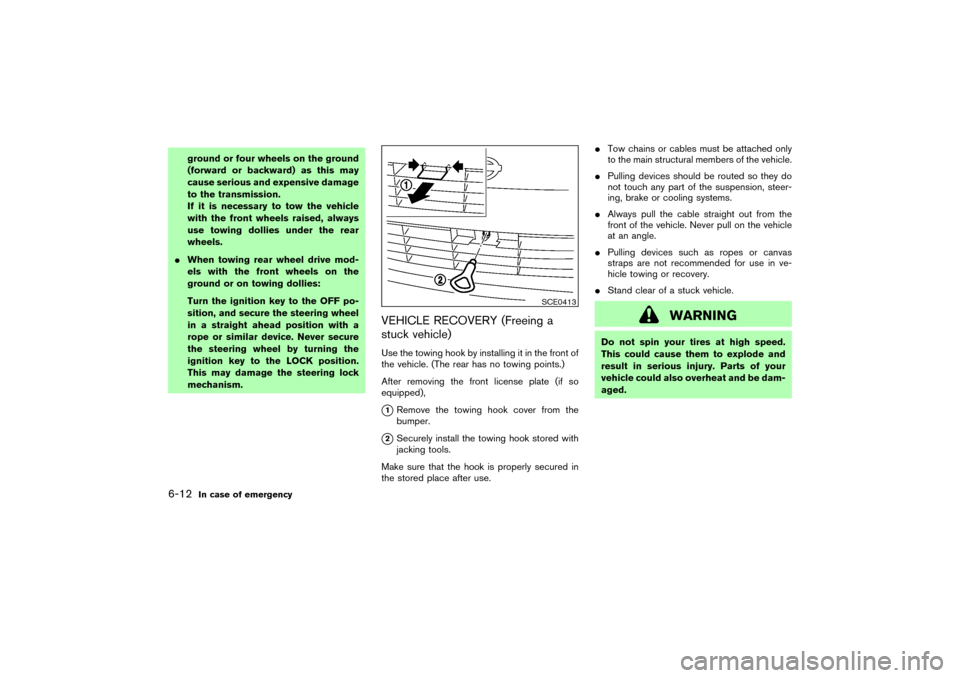Page 172 of 262

verse), or the automatic transmission
into P (Park).
�Never change tires when the vehicle
is on a slope, ice or slippery areas.
This is hazardous.
�Never change tires if oncoming traffic
is close to your vehicle. Wait for pro-
fessional road assistance.
�When a spare tire is mounted or a
wheel is replaced, tire pressure will
not be indicated and the low tire
pressure warning system will not
function. Contact your NISSAN
dealer as soon as possible for tire
replacement and/or system reset-
ting. (For models with the low tire
pressure warning system)
Blocking wheelsPlace suitable blocks at both the front and back
of the wheel diagonally opposite the flat tire to
prevent the vehicle from moving when it is jacked
up.
WARNING
Be sure to block the wheel as the ve-
hicle may move and could cause per-
sonal injury.
Getting the spare tire and toolsRemove spare tire and jacking tools from the
storage area located in the luggage/trunk as
illustrated.
Coupe models:
1. Spare tire — Turn the retainer counterclock-
wise to remove.
2. Jack — Turn it counterclockwise to remove.
3. Jacking tools
MCE0001
SCE0409
Coupe modelsIn case of emergency
6-3
�
04.1.22/Z33-D/V5.0
�
Page 173 of 262
Roadster models:
1. Spare tire — Turn the retainer counterclock-
wise to remove.
2. Jack — Unfasten the belt and lift the jack up
to remove.
3. Jacking tools — They are in the tool bag.
Jacking up the vehicle and removing
the damaged tireCarefully read the caution label attached to
the jack body and the following instruc-
tions.
1. Place the jack directly under the jack-up point
as illustrated above so that top of the jack
contacts the vehicle at the jack up point.
Align the jack head between the two notches
in the front or the rear as shown. Also fit the
groove of the jack head between the notches
as shown.
SCE0491
Roadster models
SCE0410
6-4
In case of emergency
�
04.1.22/Z33-D/V5.0
�
Page 175 of 262

Installing the spare tireThe spare tire is designed for emergency
use. See specific instructions under the
heading “Wheels and tires” in the “8. Main-
tenance and do-it-yourself” section.
1. Clean any mud or dirt from the surface
between the wheel and hub.
2. Carefully put the wheel on and tighten the
wheel nuts finger tight. When replacing a
front tire, make sure the hole in the spare tire
wheel is aligned with the pin on the brake
rotor.
3. With the wheel nut wrench, tighten wheelnuts alternately and evenly in the sequence
illustrated (
�1
-�5) until they are tight.
4. Lower the vehicle slowly until the tire touches
the ground. Then, with the wheel nut wrench,
tighten the wheel nuts securely in the se-
quence as illustrated. Lower the vehicle com-
pletely.
WARNING
�Incorrect wheel nuts or improperly
tightened wheel nuts can cause the
wheel to become loose or come off.
This could cause an accident.
�Do not use oil or grease on the wheel
studs or nuts. This could cause the
nuts to become loose.
�Retighten the wheel nuts when the
vehicle has been driven for 600 miles
(1,000 km) (also in cases of a flat tire,
etc.).
As soon as possible tighten the wheel nuts
to the specified torque with a torque
wrench.Wheel nut tightening torque:
80 ft-lb (108 N⋅m)
The wheel nuts must be kept tightened to
specification at all times. It is recom-
mended that wheel nuts be tightened to
specification at each lubrication interval.
Adjust tire pressure to the COLD pressure.
COLD pressure:
After vehicle has been parked for three
hours or more or driven less than 1 mile
(1.6 km).
COLD tire pressures are shown on the Tire
and Loading Information label affixed to
the driver’s side center pillar.
For models equipped with the low tire
pressure warning system:
After adjusting tire pressure to the COLD tire
pressure, the display of the tire pressure infor-
mation may show higher pressure than the
COLD tire pressure after the vehicle has been
driven more than 1 mile (1.6 km). This is because
the tire pressurizes as the tire temperature rises.
This does not indicate a system malfunction.
Stowing the tire and toolsSecurely store the spare tire and jacking equip-
ment in the vehicle.
SCE0039
6-6
In case of emergency
�
04.1.22/Z33-D/V5.0
�
Page 176 of 262

WARNING
�Always make sure that the spare tire
and jacking equipment are properly
secured after use. Such items can
become dangerous projectiles in an
accident or sudden stop.
�The spare tire is designed for emer-
gency use. See specific instructions
under the heading “Wheels and tires”
in the “8. Maintenance and do-it-
yourself” section.To start your engine with a booster battery, the
instructions and precautions below must be
followed.
WARNING
�If done incorrectly, jump starting can
lead to a battery explosion, resulting
in severe injury or death. It could also
damage your vehicle.
�Explosive hydrogen gas is always
present in the vicinity of the battery.
Keep all sparks and flames away
from the battery.
�Do not allow battery fluid to come
into contact with eyes, skin, cloth or
painted surfaces. Battery fluid is a
corrosive sulphuric acid solution
which can cause severe burns. If the
fluid should come into contact with
anything, immediately flush the con-
tacted area with water.
�Keep battery out of the reach of chil-
dren.
�The booster battery must be rated at12 volts. Use of an improperly rated
battery can damage your vehicle.
�Whenever working on or near a bat-
tery, always wear suitable eye protec-
tors (for example, goggles or indus-
trial safety spectacles) and remove
rings, metal bands, or any other jew-
elry. Do not lean over the battery
when jump starting.
�Do not attempt to jump start a frozen
battery. It could explode and cause
serious injury.JUMP STARTING
In case of emergency
6-7
�
04.1.22/Z33-D/V5.0
�
Page 181 of 262

ground or four wheels on the ground
(forward or backward) as this may
cause serious and expensive damage
to the transmission.
If it is necessary to tow the vehicle
with the front wheels raised, always
use towing dollies under the rear
wheels.
�When towing rear wheel drive mod-
els with the front wheels on the
ground or on towing dollies:
Turn the ignition key to the OFF po-
sition, and secure the steering wheel
in a straight ahead position with a
rope or similar device. Never secure
the steering wheel by turning the
ignition key to the LOCK position.
This may damage the steering lock
mechanism.
VEHICLE RECOVERY (Freeing a
stuck vehicle)Use the towing hook by installing it in the front of
the vehicle. (The rear has no towing points.)
After removing the front license plate (if so
equipped),�1Remove the towing hook cover from the
bumper.
�2Securely install the towing hook stored with
jacking tools.
Make sure that the hook is properly secured in
the stored place after use.�Tow chains or cables must be attached only
to the main structural members of the vehicle.
�Pulling devices should be routed so they do
not touch any part of the suspension, steer-
ing, brake or cooling systems.
�Always pull the cable straight out from the
front of the vehicle. Never pull on the vehicle
at an angle.
�Pulling devices such as ropes or canvas
straps are not recommended for use in ve-
hicle towing or recovery.
�Stand clear of a stuck vehicle.
WARNING
Do not spin your tires at high speed.
This could cause them to explode and
result in serious injury. Parts of your
vehicle could also overheat and be dam-
aged.
SCE0413
6-12
In case of emergency
�
04.1.22/Z33-D/V5.0
�